Experimental and Numerical Study on Hysteretic Behavior of Frictional Energy Dissipation Steel Truss
Abstract
:1. Introduction
2. Configuration of FED-ST
3. Experimental Program
3.1. Design of Specimen
3.2. Experiment Setup
4. Test Results and Discussion
4.1. Failure Characteristics
4.2. Hysteretic Responses
4.3. Energy Dissipation Capability
5. Numerical Simulation
5.1. Overview
5.2. Materials Models
5.2.1. Concrete
5.2.2. Steel
5.3. Validation of the Finite Element Model
5.4. Effect of Cover Plate Width
6. Conclusions
- The seismic behavior of the FED-ST has been experimentally investigated on a 1:2.5-scale specimen. The experiment verified that the FED-ST showed the expected failure mode and expected three-stage behavior under lateral forces. The ultimate lateral displacement of the FED-ST specimen is 2.6 times that of the traditional truss specimen, the ductility coefficient is 6.9 times that of the traditional truss specimen, and the cumulative energy dissipation is 7.3 times that of the conventional truss specimen. The equivalent viscous damping coefficient of the FED-ST specimen remained at a high level during the test. FED-ST has better energy dissipation capacity and ductility compared to conventional trusses, which will greatly improve the seismic behavior of the STFS. The steel used in this experiment is Q355 steel, while the seismic performance of trusses made of other types of steel needs further research.
- The proposed FE model was able to predict the response of the frictional energy dissipation steel truss subjected to lateral load based on the deformation behavior of the FED-ST and key characteristics of the load-displacement curves. Therefore, it is advised that it be applied in actual practice for structural design and analysis.
- The parametrical numerical analyses reveal that the smaller the width of the cover plate connecting the web members and the angle members, the smaller the angles’ deformations. The use of narrow cover plates can effectively control the torsional bulking of angles. Moreover, when the width of the cover plate is less than the distance of the centers of mass of the two angles, the deformation of the angles is significantly reduced. Therefore, it is recommended that the width of the cover plates be less than the distance of the centers of mass of the two angles during design.
Author Contributions
Funding
Institutional Review Board Statement
Informed Consent Statement
Data Availability Statement
Conflicts of Interest
References
- Taranath, B.S. Steel, Concrete, and Composite Design of Tall Buildings; McGraw-Hill Professional Pub: New York, NY, USA, 1998. [Google Scholar]
- Goody, M.E.; LeMessurier, W.J. High-Rise Housing in Steel—The Staggered Truss System; Research Report (R67-7 Civil Engineering); Department of Architecture and Civil Engineering, Massachusetts Institute of Technology: Cambridge, MA, USA, 1967. [Google Scholar]
- Zhou, X.; He, Y.; Xu, L.; Zhou, Q. Experimental study and numerical analyses on seismic behaviors of staggered-truss system under low cyclic loading. Thin-Walled Struct. 2009, 47, 1343–1353. [Google Scholar] [CrossRef]
- Chen, C.; Zhang, W. Experimental study of the mechanical behavior of steel staggered truss system under pool fire conditions. Thin-Walled Struct. 2011, 49, 1442–1451. [Google Scholar] [CrossRef]
- Kim, J.; Lee, J.; Kim, B. Seismic retrofit schemes for staggered truss structures. Eng. Struct. 2015, 102, 93–107. [Google Scholar] [CrossRef]
- Kim, J.; Kim, S. Performance-based seismic design of staggered truss frames with friction dampers. Thin-Walled Struct. 2017, 111, 197–209. [Google Scholar] [CrossRef]
- Zhou, X.; Zhou, Z.; Zhou, Q.; Huang, W.; Guo, W. Hysteretic behavior and design considerations of staggered truss framing systems. J. Build. Eng. 2023, 72, 106696. [Google Scholar] [CrossRef]
- Zhou, X.; Huang, W.; Zhou, Q.; Zhou, Z.; Guo, W. Pseudo-dynamic test and numerical analyses of staggered truss framing systems. In Structures; Elsevier: Amsterdam, The Netherlands, 2022; Volume 45, pp. 509–522. [Google Scholar]
- Zhou, X.; Chen, Y.; Ke, K.; Yam, M.C.; Li, H. Hybrid steel staggered truss frame (SSTF): A probabilistic spectral energy modification coefficient surface model for damage-control evaluation and performance insights. J. Build. Eng. 2022, 45, 103556. [Google Scholar] [CrossRef]
- FEMA 450; NEHRP Recommended Provisions for Seismic Regulations for New Buildings and Other Structures. The Building Seismic Safety Council: Washington, DC, USA, 2003.
- Boggian, F.; Tardo, C.; Aloisio, A.; Marino, E.M.; Tomasi, R. Experimental cyclic response of a novel friction connection for seismic retrofitting of RC buildings with CLT panels. J. Struct. Eng. 2022, 148, 04022040. [Google Scholar] [CrossRef]
- Qiu, C.; Liu, J.; Jiang, T.; Jia, J.; Du, X. Experimental study on a steel self-centering rocking column with SMA slip friction dampers. Eng. Struct. 2023, 274, 115126. [Google Scholar] [CrossRef]
- Zhang, P.; Yam, M.C.H.; Ke, K.; Liu, Y.; Fai, K. Performance investigations on steel-brass friction devices. In Proceedings of the 2023 World Congress on Advances in Structural Engineering and Mechanics (ASEM23), Seoul, Republic of Korea, 16–18 August 2023. [Google Scholar]
- Kim, Y.; Shahriyer, H.; Hu, J. Seismic Performance Evaluation According to HSS and CFST Columns of 3D Frame Buildings with Rubber Friction Bearing (RFB). Materials 2022, 15, 1281. [Google Scholar] [CrossRef]
- Bruschi, E.; Zoccolini, L.; Cattaneo, S.; Quaglini, V. Experimental Characterization, Modeling, and Numerical Evaluation of a Novel Friction Damper for the Seismic Upgrade of Existing Buildings. Materials 2023, 16, 1933. [Google Scholar] [CrossRef]
- Jarrahi, H.; Asadi, A.; Khatibinia, M.; Etedali, S. Optimal design of rotational friction dampers for improving seismic performance of inelastic structures. J. Build. Eng. 2020, 27, 100960. [Google Scholar] [CrossRef]
- Veismoradi, S.; Yousef-Beik, S.M.M.; Zarnani, P.; Quenneville, P. Development and parametric study of a new self-centering rotational friction damper. Eng. Struct. 2021, 235, 112097. [Google Scholar] [CrossRef]
- Li, Y.; Zhang, H.; Wang, J.; Yu, H.; Ma, K.; Zhang, X.; Ji, W.; Li, R. Experimental investigation on the seismic behavior of a novel self-centering friction damper. J. Build. Eng. 2023, 76, 107384. [Google Scholar] [CrossRef]
- Ghorbani, H.R.; Rofooei, F.R. A novel double slip loads friction damper to control the seismic response of structures. Eng. Struct. 2020, 225, 111273. [Google Scholar] [CrossRef]
- Zhou, Z.; Zhou, X.; Zhou, Q.; Guo, W.; Huang, W. Development and experimental validation of a novel frictional energy dissipation steel truss. J. Constr. Steel Res. 2023, 211, 108150. [Google Scholar] [CrossRef]
- Zhang, A.; Ye, Q.; Wang, Z. Experimental investigation on behavior of re-centering energy dissipative brace. Eng. Struct. 2020, 213, 110606. [Google Scholar] [CrossRef]
- Lu, Y.; Liu, Y.; Wang, Y.; Liu, J.; Huang, X. Development of a novel buckling-restrained damper with additional friction energy dissipation: Component tests and structural verification. Eng. Struct. 2023, 274, 115188. [Google Scholar] [CrossRef]
- AISC. Steel Design Guide Series 14: Staggered Truss Framing Systems; American Institute of Steel Construction: Chicago, IL, USA, 2003. [Google Scholar]
- CECS 323: 2012; Technical Specification for Staggered Truss Steel Framing System. China Planning Press: Beijing, China, 2012. (In Chinese)
- GB 50017-2017; Standard for Design of Steel Structures. China Architecture & Building Press: Beijing, China, 2017. (In Chinese)
- GB/T 50081-2019; Standard for Test Methods of Concrete Physical and Mechanical Properties. China Architecture & Building Press: Beijing, China, 2019. (In Chinese)
- GB 50010-2010; Code for Design of Concrete Structures. China Architecture & Building Press: Beijing, China, 2015. (In Chinese)
- GB 50011-2010; Code for Seismic Design of Buildings. China Architecture & Building Press: Beijing, China, 2010. (In Chinese)
- ANSI/AISC 341-2016; Seismic Provisions for Structural Steel Buildings. American Institute of Steel Construction: Chicago, IL, USA, 2016.
- Wang, L.; An, Y.; Ding, F.; Kuang, Y.; Ma, Q.; Tan, S.; Zhang, W.; Zhao, P.; Ren, E. Numerical Investigation of Composite Behavior and Strength of Rectangular Concrete-Filled Cold-Formed Steel Tubular Stub Columns. Materials 2021, 14, 6221. [Google Scholar] [CrossRef]
- Li, B.; Ding, F.; Lu, D.; Lyu, F.; Huang, S.; Cao, Z.; Wang, H. Finite Element Analysis of the Mechanical Properties of Axially Compressed Square High-Strength Concrete-Filled Steel Tube Stub Columns Based on a Constitutive Model for High-Strength Materials. Materials 2022, 15, 4313. [Google Scholar] [CrossRef]
- Ding, F.; Ying, X.; Zhou, L.; Yu, Z. Unified calculation method and its application in determining the uniaxial mechanical properties of concrete. Front. Archit. Civ. Eng. China 2011, 5, 381–393. [Google Scholar] [CrossRef]
- Ding, F.-X.; Yin, G.-A.; Wang, L.-P.; Hu, D.; Chen, G.-Q. Seismic performance of a non-through-core concrete between concrete-filled steel tubular columns and reinforced concrete beams. Thin-Walled Struct. 2017, 110, 14–26. [Google Scholar] [CrossRef]
- Zhou, Q.-S.; Fu, H.-W.; Ding, F.-X.; Liu, X.-M.; Yu, Y.-J.; Wang, L.-P.; Yu, Z.-W.; Luo, L. Seismic behavior of a new through-core connection between concrete-filled steel tubular column and composite beam. J. Constr. Steel Res. 2019, 155, 107–120. [Google Scholar] [CrossRef]


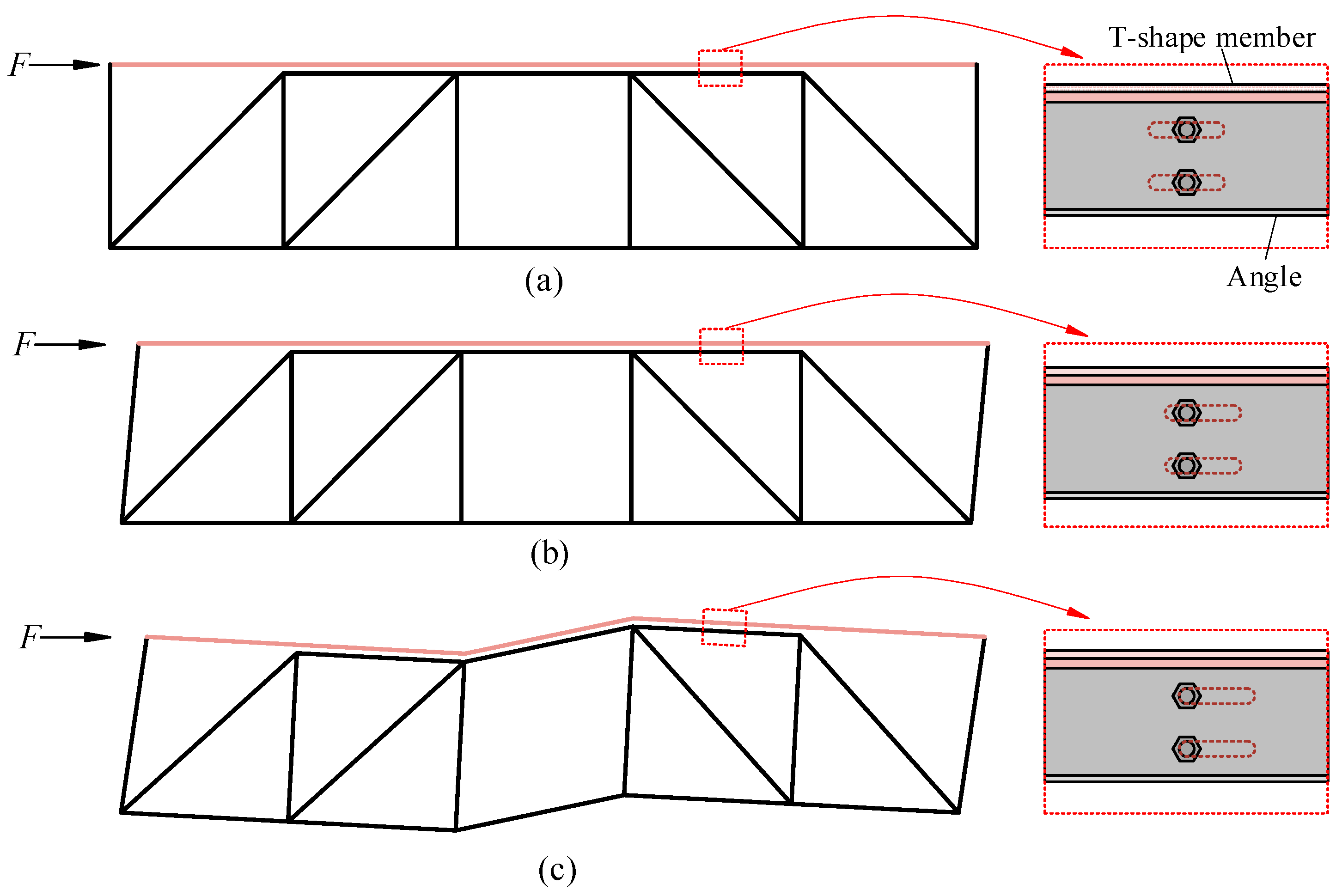

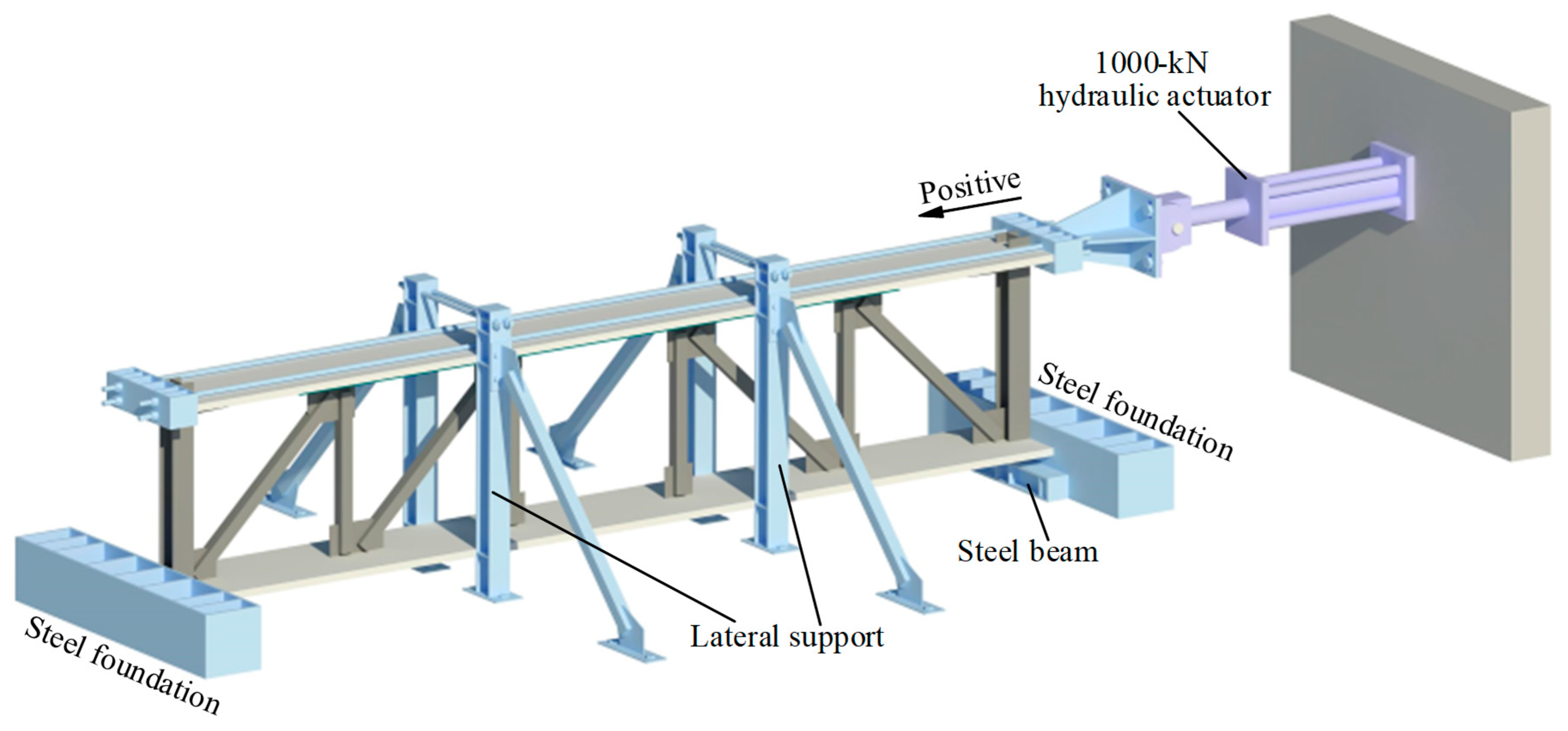

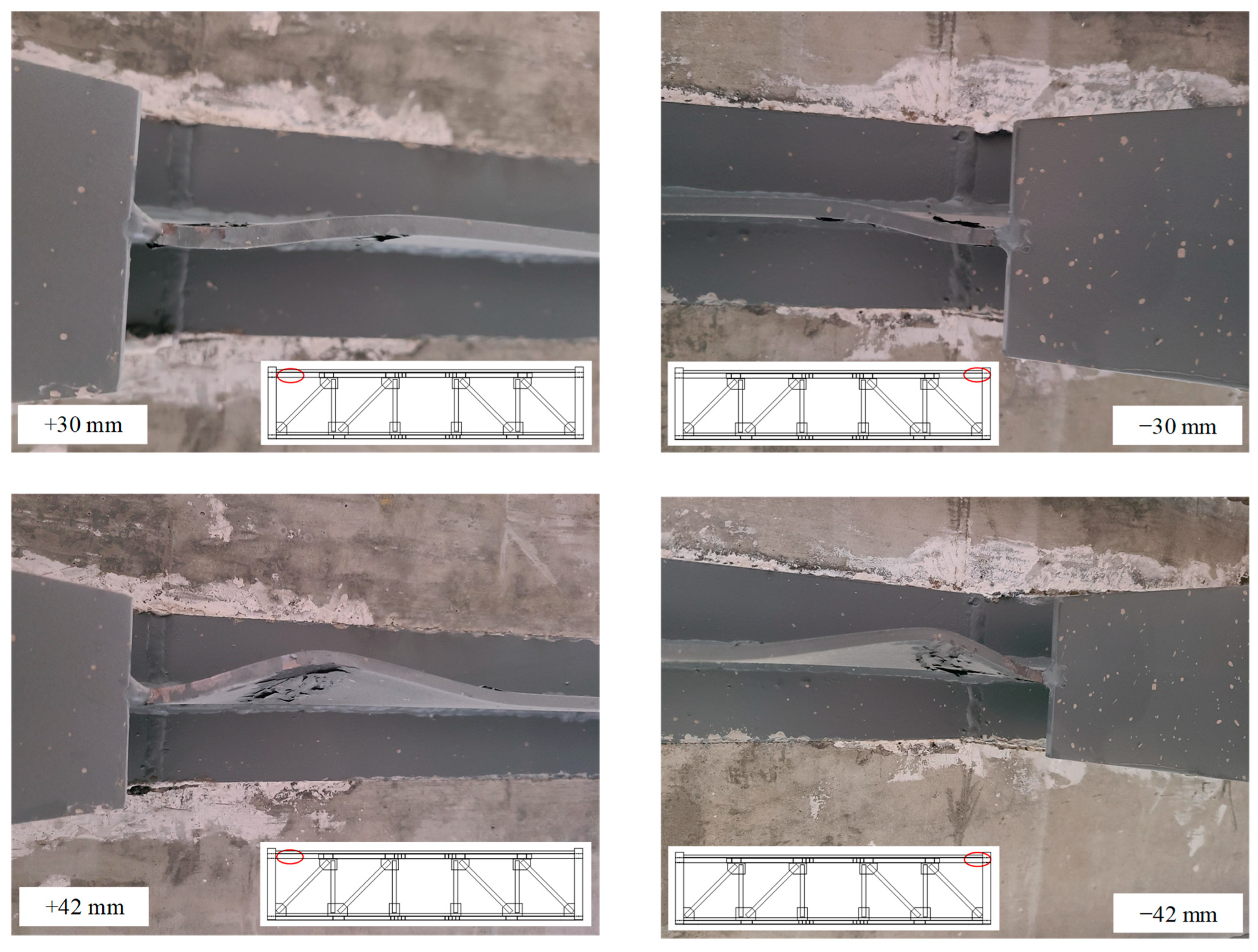
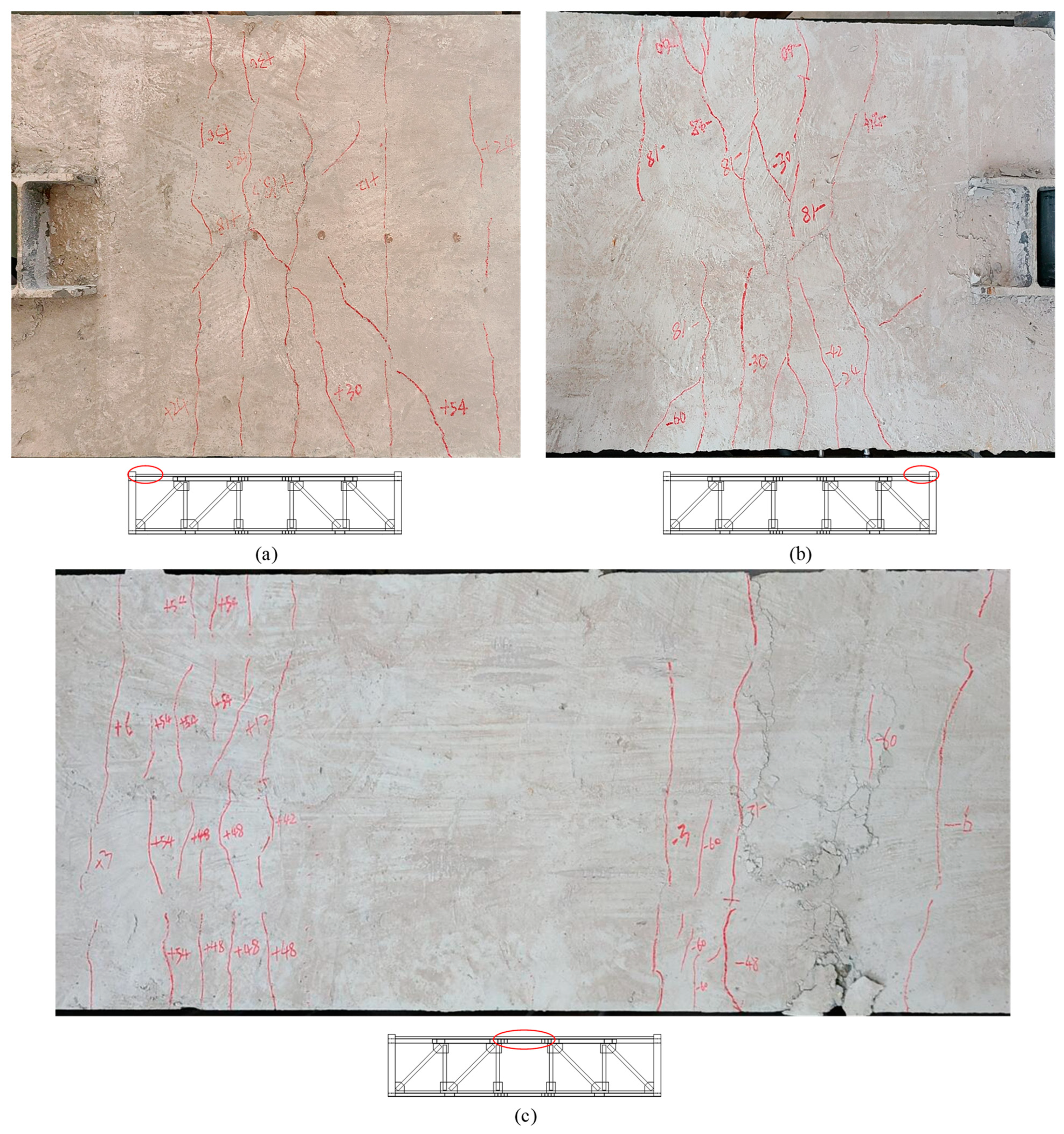
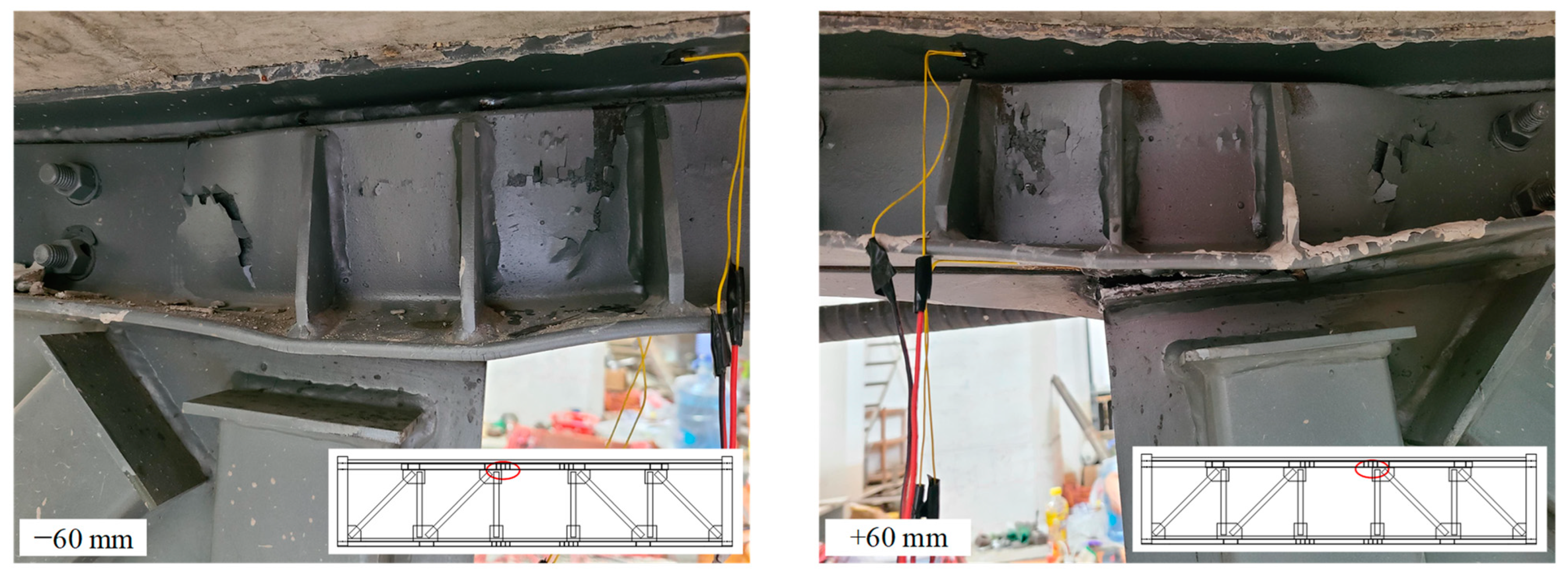
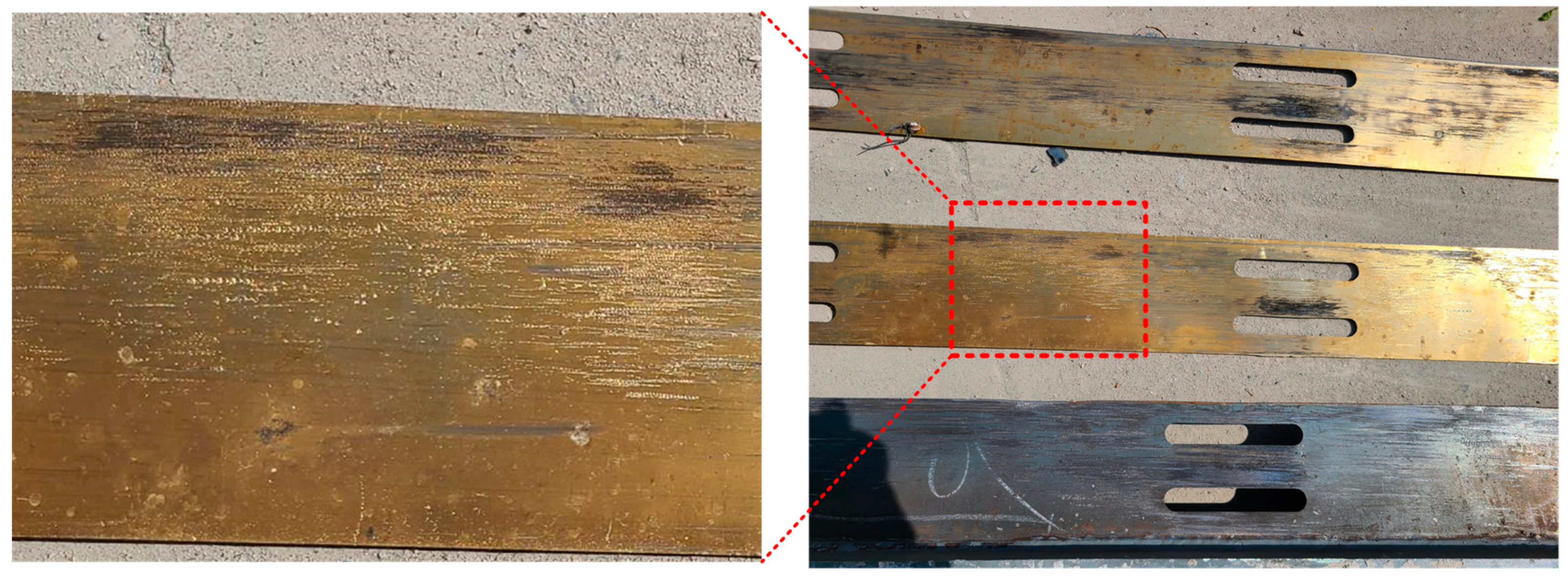
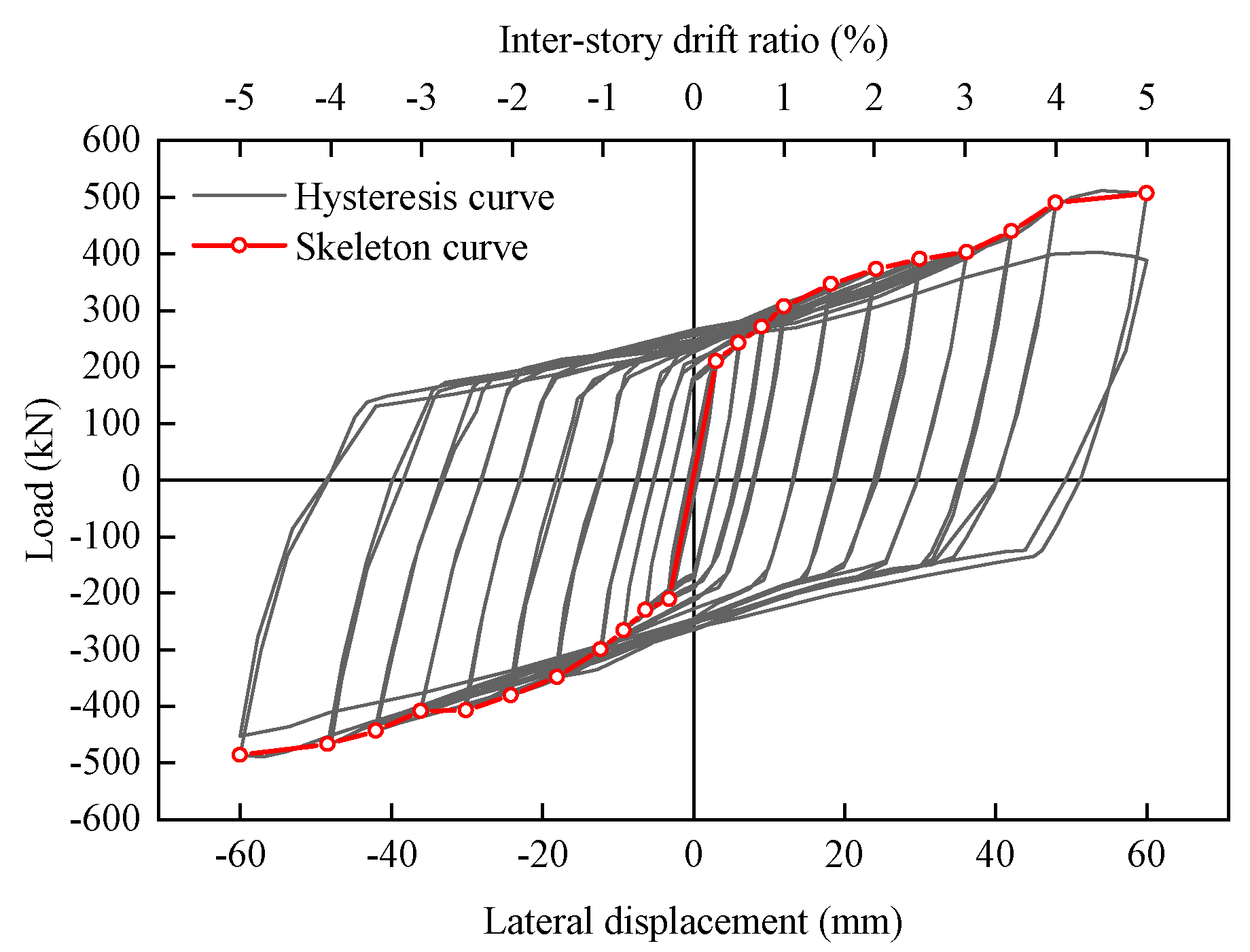
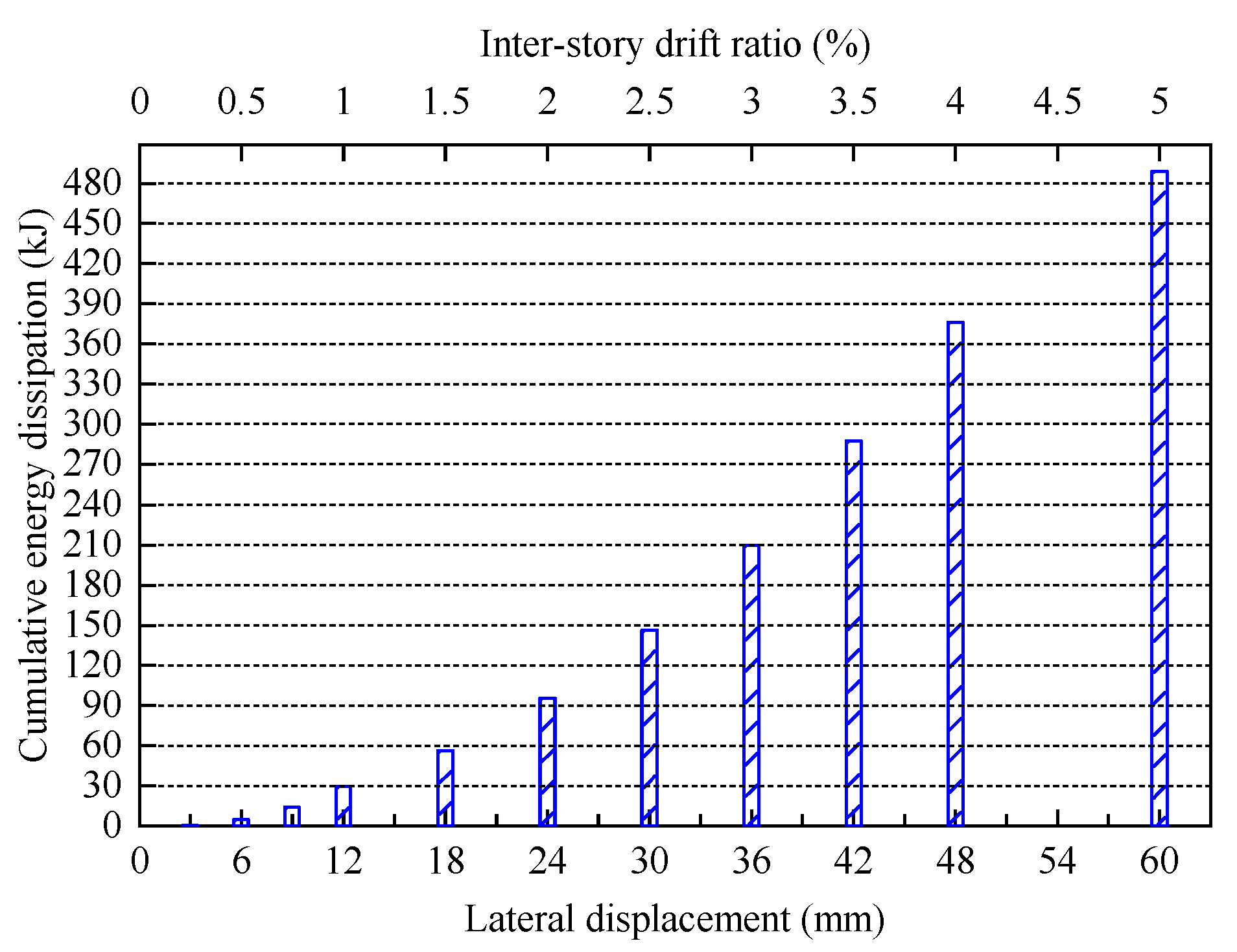




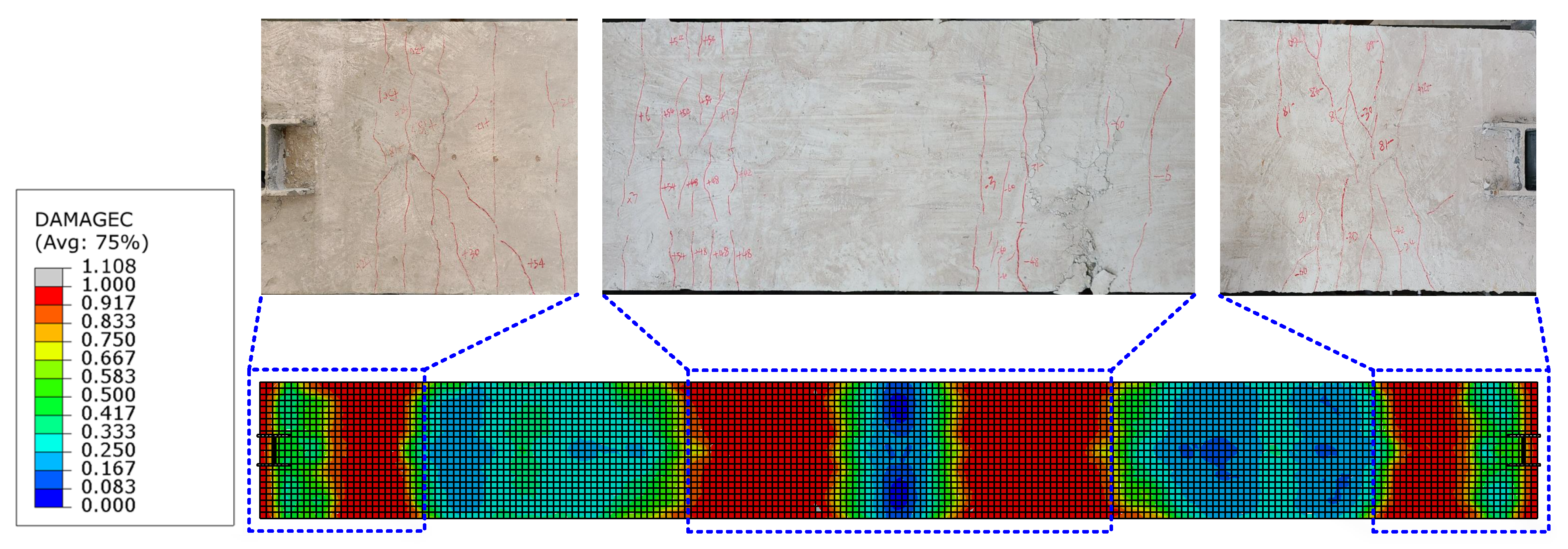
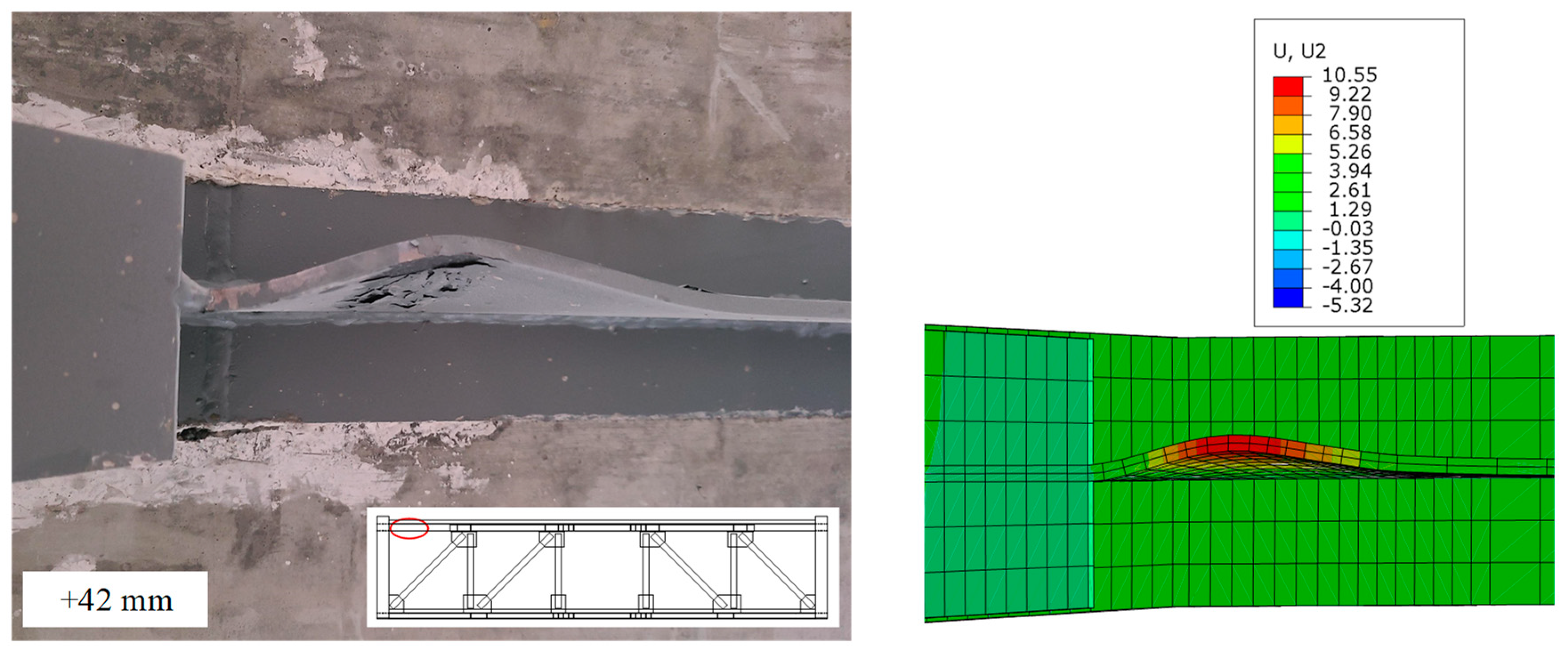





| Component | Material | Steel Thickness | /MPa | /MPa | Yield Strength /MPa | Ultimate Strength /MPa |
|---|---|---|---|---|---|---|
| Slabs | Concrete C30 | - | 34.8 | 31.4 | - | - |
| Chords | Steel Q355 | 5 mm | - | - | 407 | 589 |
| Webs | 3.2 mm | - | - | 407 | 551 |
| Dilatation Angle | Eccentricity Ratio | fb0 /fc0 | K | Viscosity Coefficient |
|---|---|---|---|---|
| 40 | 0.1 | 1.225 | 0.6667 | 0 |
| Es | Poisson’s Ratio | Kinematic Hard Parameters | Change Ratio of the Back Stress | Hardening Parameter b | |
|---|---|---|---|---|---|
| 206,000 | 0.3 | 7500 | 50 | 0.1 |
Disclaimer/Publisher’s Note: The statements, opinions and data contained in all publications are solely those of the individual author(s) and contributor(s) and not of MDPI and/or the editor(s). MDPI and/or the editor(s) disclaim responsibility for any injury to people or property resulting from any ideas, methods, instructions or products referred to in the content. |
© 2023 by the authors. Licensee MDPI, Basel, Switzerland. This article is an open access article distributed under the terms and conditions of the Creative Commons Attribution (CC BY) license (https://creativecommons.org/licenses/by/4.0/).
Share and Cite
Zhou, Z.; Zhou, X.; Zhou, Q.; Fu, H.; Liu, S. Experimental and Numerical Study on Hysteretic Behavior of Frictional Energy Dissipation Steel Truss. Materials 2023, 16, 6273. https://doi.org/10.3390/ma16186273
Zhou Z, Zhou X, Zhou Q, Fu H, Liu S. Experimental and Numerical Study on Hysteretic Behavior of Frictional Energy Dissipation Steel Truss. Materials. 2023; 16(18):6273. https://doi.org/10.3390/ma16186273
Chicago/Turabian StyleZhou, Zhibin, Xuhong Zhou, Qishi Zhou, Huawei Fu, and Shuaishuai Liu. 2023. "Experimental and Numerical Study on Hysteretic Behavior of Frictional Energy Dissipation Steel Truss" Materials 16, no. 18: 6273. https://doi.org/10.3390/ma16186273
APA StyleZhou, Z., Zhou, X., Zhou, Q., Fu, H., & Liu, S. (2023). Experimental and Numerical Study on Hysteretic Behavior of Frictional Energy Dissipation Steel Truss. Materials, 16(18), 6273. https://doi.org/10.3390/ma16186273






